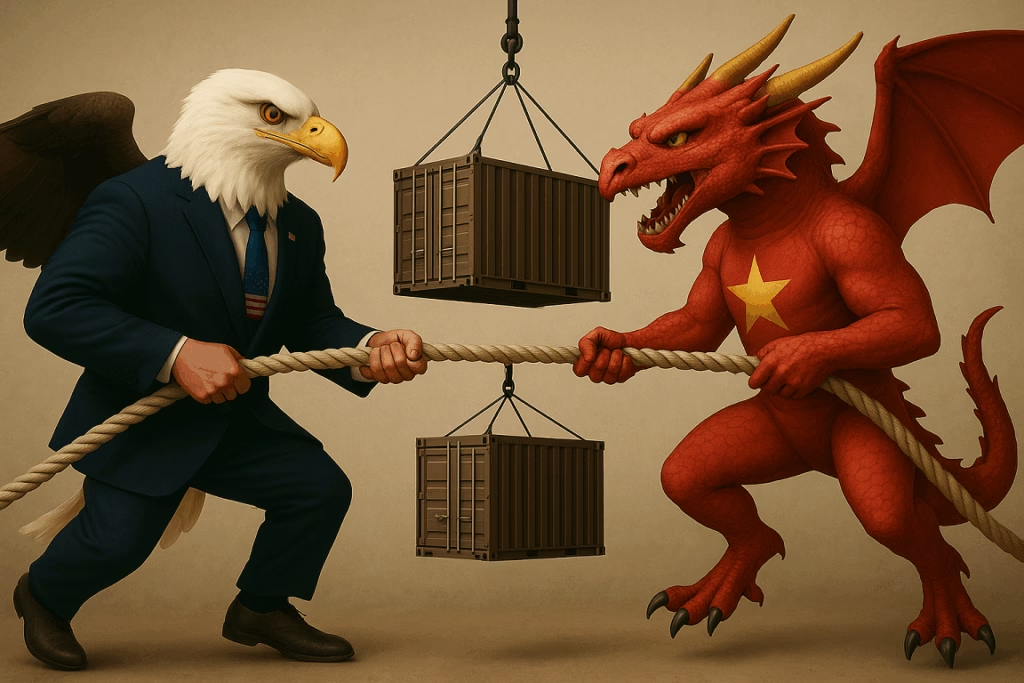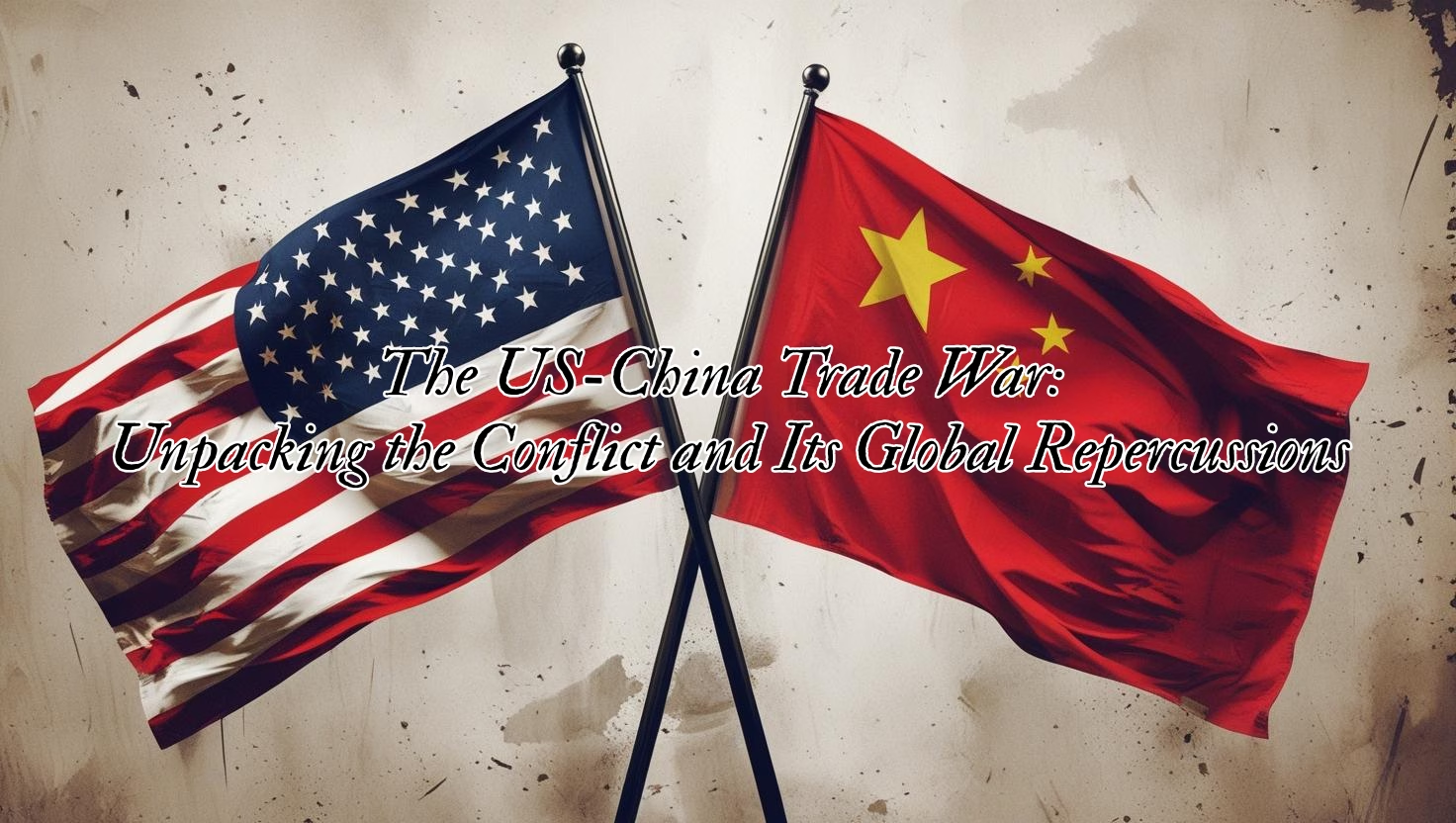Introduction:
The U.S.-China trade war refers to a period of escalating tariffs and retaliatory trade practices between the United States and China. Officially, the US-China trade war began during President Trump’s first administration, in 2018. The Trump administration raised concerns about China’s trade practices and the bilateral trade imbalance and imposed significant tariffs on Chinese imports, which triggered the conflict. In response, China immediately imposed tariffs on US goods. The conflict remains unresolved, contributing significantly to ongoing political tensions and economic consequences in both countries. The following narrative outlines the origins of the US-China trade war, its economic impact, and recent developments in the ongoing conflict.
Table of Contents
Origin of The Dispute:
The US-China trade war officially began in 2018 when then-President Donald Trump imposed significant tariffs and other trade barriers on Chinese goods during his first term. The main reasons for imposing these tariffs were unfair trade practices, a huge trade imbalance, and intellectual property theft. China retaliated by imposing tariffs on US goods, further escalating the conflict.
The US cited China’s violation of fair-trade rules as the primary reason behind its tariffs, particularly under the “Made in China 2025” initiative launched in 2015, which aims to achieve global dominance in high-tech industries. The US administration saw this as a threat to its own innovation and economic leadership.
Major Escalations:
Over the next two years, both nations imposed tariffs on each other. At the height of the tensions, the United States imposed tariffs on more than $360 billion worth of Chinese goods, while China targeted more than $110 billion worth of U.S. goods in its retaliatory measures. These actions had a tangible impact across a broad spectrum of industries, including agriculture, automotive manufacturing, electronics, and consumer products.
Although a “phase one” trade agreement was signed in January 2020, which provided temporary relief, most tariffs remain in place. The COVID-19 pandemic has further strained US-China relations, putting trade concerns on the back burner and exacerbating broader geopolitical rivalries.
During the tenure of President Joe Biden, tariffs were kept in place, and additional levies were imposed on Chinese goods.
In early 2025, the conflict escalated significantly under the second Trump administration. The United States imposed 145% tariffs on Chinese goods, and China responded with 125% tariffs on American goods. These measures are expected to reduce global merchandise trade by 0.2%. Despite the tariff war, both countries have removed some products, such as major electronics goods, from their lists.

Recent Developments:
On April 2, a day President Trump calls “Liberation Day“, he announced a “reciprocal tariff” of at least 10% on all US imports and higher tariffs on imports from 57 countries. The retaliatory spiral resulted in a 145% tariff on Chinese goods by the US and a 125% tariff on US goods by China.
In a dramatic policy shift later this year, the United States cut tariffs on a wide range of Chinese imports from 145% to 30%, one of the biggest reductions in tensions since the trade war began. China responded in kind, cutting tariffs on American goods from 125% to 10%. The move followed months of quiet diplomacy amid growing domestic concerns about inflation and supply chain disruptions.
This tariff reduction agreement, which is set for a 90-day review period, is widely seen as a testing ground for further trade normalization. The bilateral thaw arrives at a critical moment. With U.S. consumer confidence declining and Chinese export growth decelerating in late 2024, both economies could gain from decreased trade tensions.
Economic Impacts:
The US-China trade war has fundamentally reshaped the economic landscape of both countries, with lasting impacts on GDP growth, inflation, industrial performance, and supply chains. While recent tariff withdrawals by both countries have brought short-term relief, the long-term consequences persist across sectors and borders.
United States:
Slower GDP Growth and Warnings of Recession:
The US-China trade war, coupled with global economic uncertainty and fiscal tightening, has had a major impact on the US economy. The Congressional Budget Office (CBO) has revised its real GDP growth forecast for 2025 to 1.9%, down from its previous forecast of 2.3% in 2024. Tariffs imposed during the height of the conflict have increased input costs for manufacturers and importers, stifled investment, and slowed the growth of productivity.
Inflation and Consumer Prices:
The tariffs acted as an indirect tax on American consumers. Companies raised the prices of Chinese goods, passing the burden on to consumers through higher prices. This dynamic contributed to persistent inflationary pressures, despite the Federal Reserve’s aggressive interest rate hikes.
Retail and Industrial Fallout:
American retailers, such as Walmart, Target, and Best Buy, have reported rising costs and shrinking profit margins over the past few years. For example, according to a recent report in “The Economic Times“, Walmart, the largest retailer in the US, said after releasing its first-quarter results that it would raise prices of its products due to the US-China Trade War.
Manufacturers have also been severely impacted, including the automotive, aerospace, and semiconductor industries, many of which depend on parts or production from China. Retaliatory tariffs have led to input shortages and decreased exports to the Chinese market.
Reconfiguration of Supply Chain:
Some U.S. companies are looking to reduce their reliance on China; the process of shifting supply chains has proven costly and complicated. Countries like Vietnam and Mexico have taken on some manufacturing operations, but a lack of infrastructure and skilled labour has limited their scalability.
China:
Targeted Growth and Economic Resilience:
Although there is western pressure and internal challenges, China has been able to maintain a relatively stable economic trajectory. In 2025, despite US pressure, the Chinese government reiterated its target of 5% GDP growth, driven by stimulus measures, increasing domestic consumption, and expanding trade with emerging markets.
China’s ability to sustain growth has been bolstered by its rapid recovery from the pandemic, large-scale investment in public infrastructure, and aggressive pursuit of new trade agreements, including the Regional Comprehensive Economic Partnership (RCEP) and the Belt and Road Initiative (BRI).
Investments in Technology and Infrastructure:
The US-China Trade war has accelerated China’s domestic innovation drive. The Chinese government, in order to reduce its dependence on the West, is investing heavily in sectors such as Artificial Intelligence (AI), semiconductor manufacturing, and green technologies. This has significantly increased domestic manufacturing capacity.
Giant Chinese companies such as BYD, Huawei, and SMIC have become more powerful. The Chinese government has increased its support for these companies while expanding its R&D budget. In 2025, China’s National Development and Reform Commission (NDRC) allocated more than $200 billion to strategic technology sectors.
Domestic Consumption:
The government’s “dual circulation” strategy, introduced in May 2020, continues to play a key role in the shift from an export-led to a domestic consumption-led growth model. This strategy is starting to yield results: retail sales and service spending have revived, and the middle class’s purchasing power has increased, although consumer sentiment remains sensitive to economic uncertainty.
Global Repercussions:
The US-China trade war has led to a significant shift in the global supply chain. As tariffs and political tensions have escalated worldwide, multinational companies have begun restructuring their supply chains to reduce their dependence on China. This has led to increased Foreign Direct Investment (FDI) and manufacturing activity in developing countries such as Vietnam, Mexico, and India, from which they have benefited.
In addition to trade flows, the trade war has accelerated economic bifurcation, with countries increasingly aligning with the US or China. This fragmentation is evident in competing technology standards, investment routes, and geopolitical blocs. Initiatives such as the US-led Indo-Pacific Economic Framework (IPEF), launched in 2022, and China’s Belt and Road Initiative, launched in 2013, are reshaping alliances and economic spheres of influence.
Moreover, the trade war has undermined trust in global institutions like the World Trade Organization (WTO), as unilateral tariffs and national security justifications erode the rules-based trading system. The long-term consequence is a more unstable and fragmented global economy. In this new paradigm, countries will have to make choices not only based on economic calculations but also on complex geopolitical allegiances.
Conclusion:
The US-China trade war has left the global economic system more fragile. However, the 90-day tariff reduction is a welcome sign of diplomacy. But the larger conflict, driven by issues such as technological dominance and ideological divisions, remains unresolved.
The economic fallout has spanned everything from GDP growth to inflation, stock markets, and supply chains. Countries and businesses are reevaluating their trade policies and globalization strategies.
The importance of sustained dialogue, transparent negotiations, and multilateral cooperation between the two countries as they look to the future is essential. Whether the US-China trade war will pave the way for a new path for global economic cooperation or lead to significant divisions will depend on the decisions of both sides and the ability of the global economy to adapt to this changing climate.



